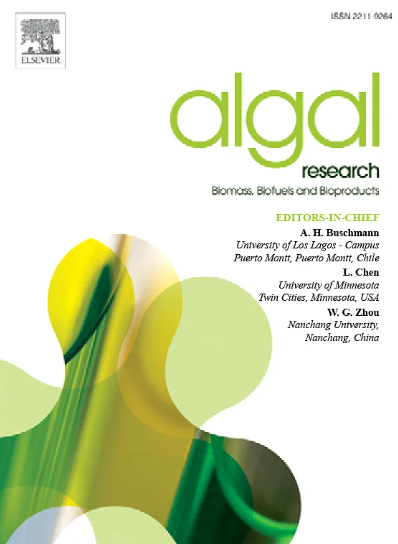Digestion and bioconversion of microalgal galactolipids by direct action of lipolytic enzymes on Chlamydomonas reinhardtii biomass
IF 4.6
2区 生物学
Q1 BIOTECHNOLOGY & APPLIED MICROBIOLOGY
Algal Research-Biomass Biofuels and Bioproducts
Pub Date : 2025-06-01
DOI:10.1016/j.algal.2025.104121
引用次数: 0
Abstract
Microalgae, like Chlamydomonas reinhardtii, are rich in polyunsaturated fatty acids (PUFAs) bound to galactolipids. Their bioaccessibility to digestive enzymes in whole cells was tested using guinea pig pancreatic lipase-related protein 2 (GPLRP2) and Fusarium solani cutinase, showing high lipolysis levels with total galactolipid fatty acid release of 93 % with GPLRP2. These enzymes also converted galactolipid fatty acids into ethyl esters with ethanol, what could facilitate PUFA recovery from microalgal biomass. In vitro digestion studies mimicking gastric and intestinal conditions revealed that human pancreatic galactolipases release α-linolenic acid (ALA) as the main free fatty acid (≥35 %). NMR analysis indicated PUFA oxidation when microalgal endogenous enzymes were not inactivated before digestion. ALA oxidation into phytoprostanes occurred, especially after lipolysis. Thus, C. reinhardtii galactolipids are bioaccessible to digestive enzymes, making them a valuable PUFA source, provided oxidation is controlled.

脂解酶直接作用于莱茵衣藻生物量的微藻半乳糖脂的消化和生物转化
微藻,如莱茵衣藻,富含与半乳糖脂结合的多不饱和脂肪酸(PUFAs)。利用豚鼠胰脂酶相关蛋白2 (GPLRP2)和茄枯镰刀菌表皮酶检测了它们在全细胞中对消化酶的生物可及性,结果显示,GPLRP2具有较高的脂解水平,总半乳糖脂脂肪酸释放量为93%。这些酶还可以用乙醇将半乳糖脂脂肪酸转化为乙酯,这有助于从微藻生物量中回收多聚脂肪酸。模拟胃肠条件的体外消化实验表明,人胰腺半乳糖酶释放α-亚麻酸(ALA)为主要游离脂肪酸(≥35%)。核磁共振分析表明,当微藻内源性酶在消化前未失活时,PUFA氧化。ALA被氧化为植物蛋白酶,特别是在脂解后。因此,莱茵半乳糖脂是消化酶的生物可及性,使其成为有价值的多聚脂肪酸来源,只要氧化得到控制。
本文章由计算机程序翻译,如有差异,请以英文原文为准。
求助全文
约1分钟内获得全文
求助全文
来源期刊

Algal Research-Biomass Biofuels and Bioproducts
BIOTECHNOLOGY & APPLIED MICROBIOLOGY-
CiteScore
9.40
自引率
7.80%
发文量
332
期刊介绍:
Algal Research is an international phycology journal covering all areas of emerging technologies in algae biology, biomass production, cultivation, harvesting, extraction, bioproducts, biorefinery, engineering, and econometrics. Algae is defined to include cyanobacteria, microalgae, and protists and symbionts of interest in biotechnology. The journal publishes original research and reviews for the following scope: algal biology, including but not exclusive to: phylogeny, biodiversity, molecular traits, metabolic regulation, and genetic engineering, algal cultivation, e.g. phototrophic systems, heterotrophic systems, and mixotrophic systems, algal harvesting and extraction systems, biotechnology to convert algal biomass and components into biofuels and bioproducts, e.g., nutraceuticals, pharmaceuticals, animal feed, plastics, etc. algal products and their economic assessment
 求助内容:
求助内容: 应助结果提醒方式:
应助结果提醒方式:


